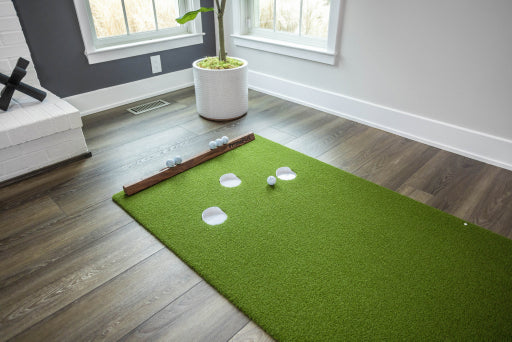Why Putting Deserves More Attention
Golfers love to analyze their drives: swing speed, ball flight, launch angle. But when it comes to putting, most of us still just toss down a few balls, hit until one drops, and call it practice.
That’s a problem. Putting makes up nearly 40% of your strokes in a round. If you shoot 85, around 34 of those strokes happen with the putter. Shaving a stroke or two on the greens can lower scores faster than adding distance off the tee.
 So why is putting often left to “feel” alone? The simple reason is that most golfers don’t have feedback. With a structured approach that combines smart practice drills and tools that track progress, you can turn putting into one of the strongest parts of your game.
So why is putting often left to “feel” alone? The simple reason is that most golfers don’t have feedback. With a structured approach that combines smart practice drills and tools that track progress, you can turn putting into one of the strongest parts of your game.
Why Feel Alone Isn’t Enough
Every golfer talks about “feel” on the greens. And while touch matters, relying on it alone makes it tough to identify what’s really holding you back.
-
A golfer might believe they’re automatic inside six feet, but in reality they’re missing half of those chances under pressure.
-
Another might feel confident about lag putting, but is consistently leaving 30-footers short, creating unnecessary 3-putts.
-
Others grind away at the wrong drills, simply because they don’t know where their weaknesses are.
Without data or structure, practice becomes a guessing game and progress stalls.
The Hidden Blind Spots in Putting Practice
When golfers don’t measure or track their putting in a systematic way, blind spots almost always creep in:
-
Patterns of misses: Many golfers repeatedly miss left or right but chalk it up to nerves, when it’s often a mechanical issue like alignment or face angle.
-
Conversion rates under pressure: You might sink 8 out of 10 short putts in practice, but only 5 out of 10 during rounds. That gap points to a routine or confidence issue.
-
Progress benchmarks: It’s easy to “feel” like you’re putting better, but unless you track 3-putt averages or make percentages, you’ll never really know.
Some golfers jot down notes in a journal after each round. We recommend tracking your putting stats throughout the round using an app like 18Birdies to get a clearer picture. The app is easy to use and integrates into your game seamlessly for effective putt tracking.
Turning Data Into Smarter Practice

Once you know where you struggle, practice can finally become purposeful. Instead of rolling balls until you’re bored, your drills target specific weaknesses:
-
Struggling with short putts (0–6 feet)? Try the Circle Drill: place tees around the hole and make putts from different angles. This builds the confidence to step up and drain pressure putts.
-
Missing too many long putts? Use the Ladder Drill: putt to progressively longer distances to sharpen touch and reduce 3-putts.
-
Inconsistent stroke mechanics? The Gate Drill (rolling putts between two tees just wider than your putter head) engrains a square strike so your stroke holds up when it matters most.
-
Want a course-like challenge? Play the One-Ball Drill, moving around the green and hitting only one putt from each spot to mimic real-round conditions.
But here’s where practice really starts to stick: tracking your results over time.
That’s where a tool like 18Birdies comes in handy. The app goes beyond just counting strokes and highlights the parts of your putting game that need the most attention. For example:
-
3-Putt Avoidance: See how often you’re leaving yourself extra work on the green. After consistent Ladder Drill practice on your PrimePutt mat, watch those numbers drop.
-
Make Percentage by Distance: Learn exactly how reliable you are from 3 feet, 6 feet, or 10 feet. Use Circle Drills indoors, then compare your practice confidence with real on-course stats.
-
Performance Trends: Over time, the app shows whether your focused practice is paying off. Maybe your 6–10 foot numbers rise, or your average putts per round falls by two strokes.
The real power is in the connection. Practice indoors with PrimePutt to refine technique, then validate your improvement with 18Birdies when you take it to the course. Together, they turn putting into a cycle of practice, feedback, and progress instead of guesswork.
A Real-World Example: Cutting 3-Putts in Half
Picture this: you’re averaging 36 putts per round, with four 3-putts. That’s pretty typical for most amateurs.
After a few weeks of closely tracking your stats, you notice that nearly all your 3-putts come from 25 feet and beyond. Instead of grinding on 4-footers, you dedicate practice time to distance control drills like the Ladder Drill on your PrimePutt mat.
A month later, you’re averaging only two 3-putts per round. That’s two strokes saved without changing your swing, your driver, or your irons.
The Future of Putting Is Structured
Golf has always been a mix of art and science. For too long, putting has leaned almost entirely on art: intuition, touch, and guesswork. The truth is that even a little structure goes a long way.
By pairing smart drills with simple tracking, whether in a notebook, through close observation, or with apps, you’ll finally know where to focus your energy. And with a PrimePutt mat, you can keep building those skills year-round, right at home.
The key is to stop practicing blindly. Start practicing with purpose, track your progress, and watch your scores drop.




